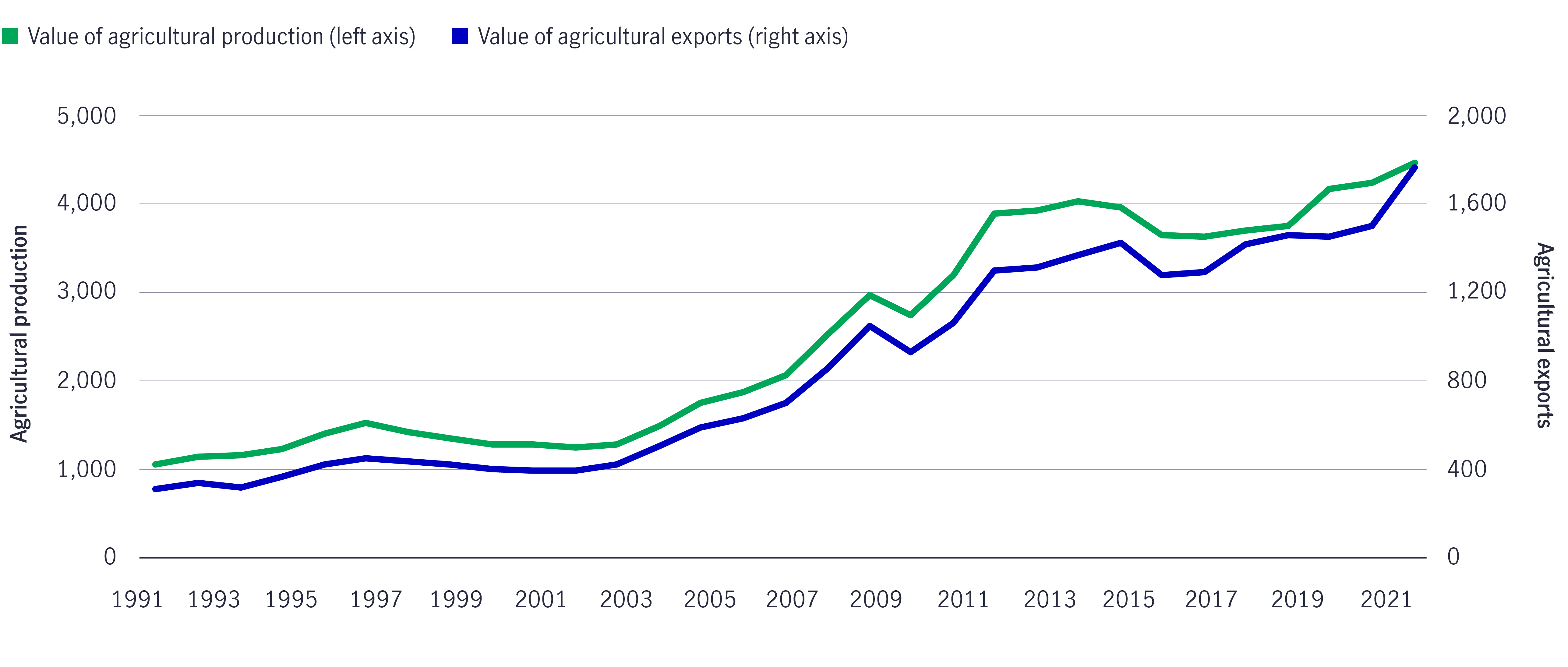Contributed content from Weiyi Zhang, Ph.D., Senior Agricultural Economist, Manulife Investment
The Opportunities and Challenges of International Trade in Agriculture
Agricultural trade is a critical component of the global food supply chain, and a vibrant global trade network that allows agricultural products to be transported across relatively manageable barriers facilitates greater efficiency of the use of limited natural resources. The international trade of agricultural products has experienced significant growth over the past 20 years, prompted by technological and scientific advancements in agricultural production, transportation, communication, and supply chain management, alongside international trade policy shifts that have led to enormous increases in volume and value.
GRAPH: Significant growth of global agricultural production and exports over three decades
Value of world total agricultural production and exports 1991–2021 (billion USD)
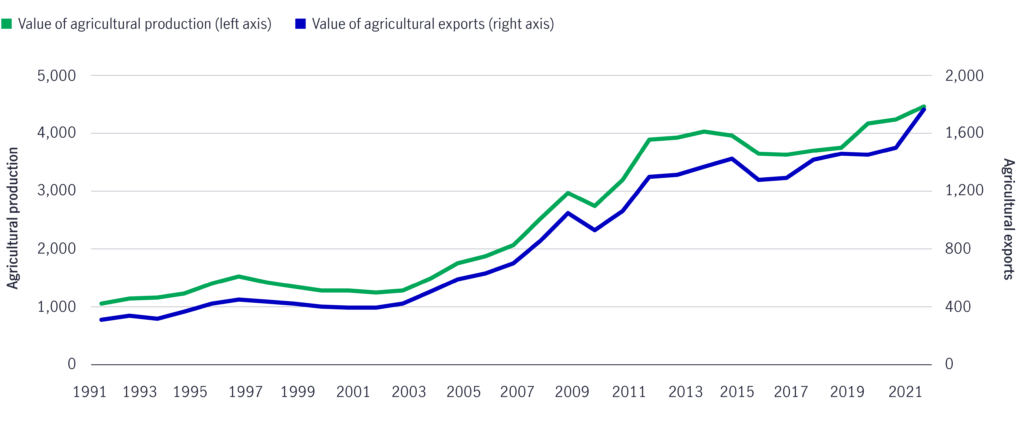
Source: United Nations FAO, accessed on August 31, 2023.
Growth in Global Agricultural Trade has Supported Production Expansion
The value of traded agricultural goods has more than quintupled during the past three decades (1991–2021), growing from $323 billion in 1991 to over $1.75 trillion in 2021. This increased trade activity has generally created value for agricultural producers and investors, with global agricultural production value more than quadrupling over the same period to over $3 trillion in additional economic gain for farmers and agribusinesses around the world. This steady rise in global agricultural trade accelerated in the early 2000s, following a decade-long global effort to admit major countries such as Russia and China to the World Trade Organization (WTO).[1] Focusing on the two recent decades since China joined the WTO in 2001, global agricultural trade values have grown by 8 percent per year between 2001 and 2021, much higher than the 2 percnet average growth seen in the previous decade. The significant and positive impact of China’s WTO membership on agricultural trade demonstrates the trading benefit of creating access to new consumer bases with growing economies and very significant populations.
Expanding Agricultural Trade Creates Value for Multiple Crop Sectors
The benefits of expanded cross-border trade in agricultural products are reflected across crop sectors, as a growing global population with diverse dietary habits and cultural backgrounds brings with it significant demand and growth opportunities for all farmers: The trade value of all major crop types grew sixfold in the 30 years between 1991 and 2021. Commodity crops, such as grains and oilseeds, were the leading drivers of crop exports, with export value increasing from $41 billion in 1991 to over $250 billion in 2021. (Grains and oilseeds are the main feedstocks used for animal feed.) A growing world economy due to a rising population leads to higher consumption of animal protein and increased demand for feed crops, particularly from emerging markets. Another crop sector experiencing high growth over the past three decades is the fruit and nut sector, where exports have grown in value by 640 percent. Increasing income levels in both developed and emerging markets have led to rising awareness of healthy nutrition, which has in turn increased consumer demand for fruit and nuts.
GRAPH: Commodity crops, fruit and nuts, and vegetables drove growth in global exports
Values of world agricultural crop exports 1991–2021 (billion USD)

Source: United Nations FAO, accessed on August 31, 2023.
Growing Trade in Commodity Crops Supports Farmers’ Returns and Broader Economic Growth
Grains and oilseeds are the most traded crops in the world. Led by corn and soybeans, they’re the main crops used in animal feed where demand has been partly driven by increasing protein consumption supported both by stable demand in developed markets and rising consumption in emerging markets. Between 2003 and 2022, corn and soybean exports both increased fivefold, while total global meat consumption grew 33 percent over the same period. Rising demand from emerging economies such as China hasn’t only contributed to an expanding global feed crop trade: In addition to supplying domestic demand through imports, emerging markets have been able to pivot their labor resources from agricultural production to industry and services, therefore optimizing resources to support their economic developments and, in turn, driving global economic growth.[2]
Higher global demand and trade have strengthened the U.S. and Brazil’s position as the leading exporters of corn and soybeans while also pushing up commodity prices: Global corn prices have risen by 200 percent over the past two decades, while soybean prices gained 144 percent. This expanded commodity crop trade has created value for both corn and soybean producers and farmland investors while supporting higher volume and prices. Likewise, farmland values have appreciated, partly supported by the higher income-generating capacity of the underlying land assets.
GRAPH: Expansion in global corn and soybean exports supported by higher meat consumption
World corn and soybean crop export values (billion USD) and meat consumption (million metric tons)
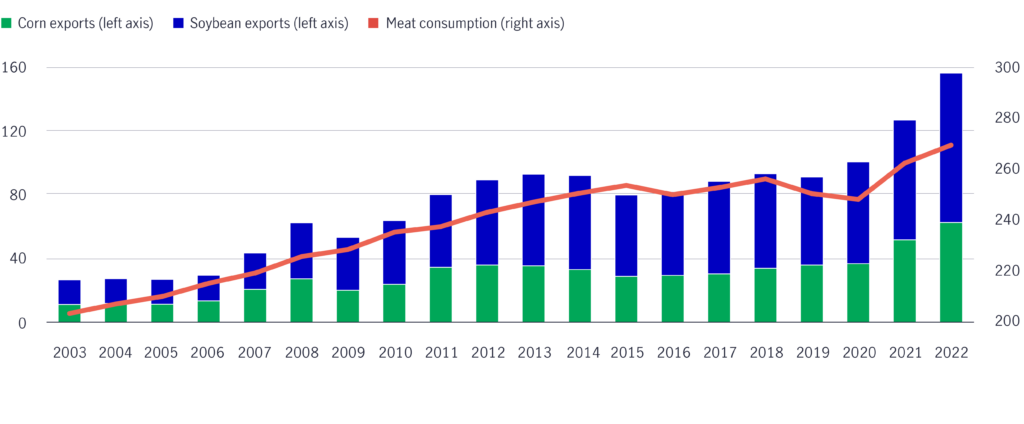
Source: Crop exports: ITC Trade Map, as of August 31, 2023; meat consumption: USDA Production, Supply, and Distribution data, as of August 31, 2023.
Rising Consumption of Tree Nuts Connects Limited Global Production With Growing Global Demand
Tree nuts such as almonds and pistachios provide an example of international trade that connects supplies from a limited number of regions with growing global demand. Due to the limited availability of a suitable climate, tree nuts are only commercially grown in a few regions, including the United States, European Union, and Middle East, while growing demand is coming from global consumers, including increasing demand from consumers located in regions without commercial-scale tree nut production. Expanding trade networks and lower trade barriers have allowed tree nuts to travel from the few producing regions to virtually all markets, while their growing global popularity has supported production expansion. As the dominant global leader in production and exports, the United States has seen its production of almonds and pistachio triple from 2003 to 2022, while exports have increased more than twofold, accounting for over 90 percent of global production and 80% of global exports.[3] This large-scale production and rising global demand have created investment opportunities for farmland investors that take advantage of economies of scale, operational experience, and competitiveness. As represented by the farmland property index of the National Council of Real Estate Investment Fiduciaries (NCREIF) [4], a widely cited farmland investment indicator, almonds and pistachios have generated an average of 17 percent and 22 percent per year, respectively, for investors during the past two decades (2003–2022).
Dependence on International Geopolitical Relationships Brings Challenges and Opportunities
International trade is dependent on global and regional partnerships, while geopolitics can play a pivotal role and create challenges for agricultural trade. For example, toward the end of the 2010s, a competitive stance between the United States and China gave rise to trade disputes between two of the world’s largest economies as China imposed tariffs on U.S. agricultural exports in retaliation for U.S. tariffs on Chinese exports. As the largest importer of U.S. soybeans, China virtually stopped importing U.S. beans in 2018 and 2019. Since China represented nearly a quarter of the U.S. soybean destination market before the trade dispute began, this episode resulted in significant financial challenges for U.S. soybean farmers, farm investors, and related agribusinesses, in addition to creating negative spillover price effects for other feed crops.
GRAPH: Australian almonds gained Chinese market share as a result of the U.S.-China trade war
Exports of almonds from Australia by market destinations (million USD)
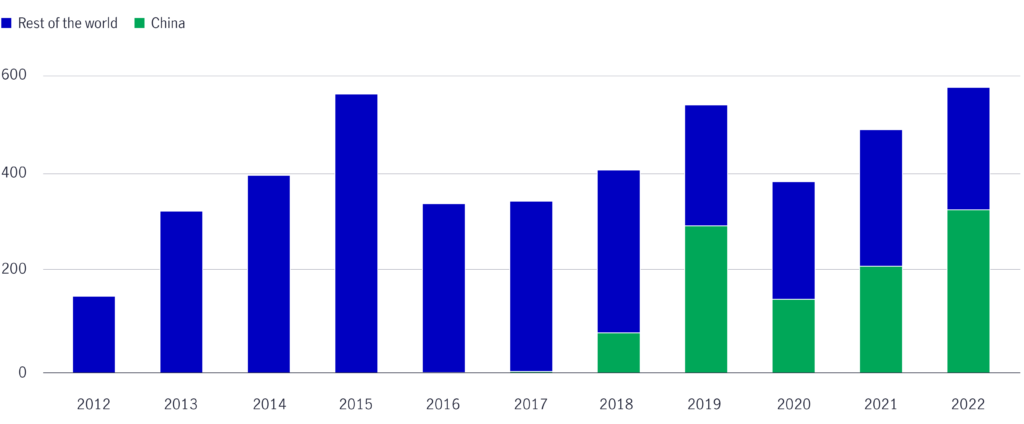
Source: ITC Trade Map, accessed on August 31, 2023.
While there are challenges associated with trading in agriculture, there are also opportunities. The loss for the U.S. soybean sector was a gain for Brazil, which has replaced the United States as China’s leading soybean supplier, even after a truce was reached between the United States and China in 2020. And when China imposed tariffs on U.S. farm products, U.S. almonds were also affected, with increasing consumption of almonds in China relying on imports to meet its vast domestic demand. Australia, the largest almond production region in the southern hemisphere, increased its almond exports to China in 2018 and 2019, resulting in its negligible pre-2018 exports to China rising to an average of $250 million from 2019 to 2022. In this case, the challenges experienced by the region’s exports once again resulted in lasting opportunities for another market.
Limited Natural Resources Set Against Growing Demand Evidence the Critical Role Played by Global Agricultural Trade
GRAPH: The imbalance between declining arable land resources and growing demand for farm goods
World arable land (hectares) and per capita consumption of tree nuts and fruits (index, 1965 level =1)
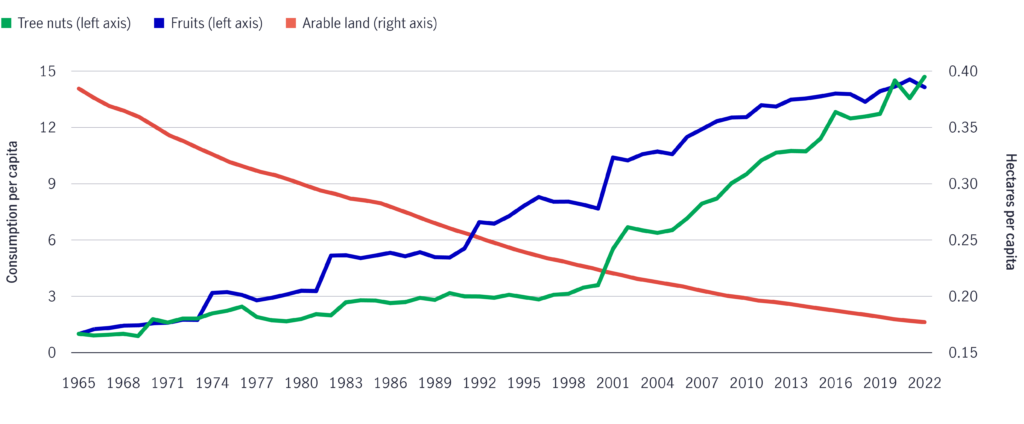
Source: USDA PSD, United Nations FAO, World Bank, as of August 31, 2023.
Global geopolitical relationships are expected to become more sensitive and capricious, and international agricultural trade may be subject to more challenges, but long-term demand and supply dynamics suggest it remains essential. The world’s population is projected to increase 25 percent by 2050, reaching 10 billion, with growth expected to accompany higher demand for agricultural products.5 Meanwhile, income growth, especially in developing countries, is likely to continue its drive toward more sophisticated diets. On the other hand, arable land remains a finite natural resource and water is becoming increasingly scarce: This imbalance between limited natural resources and a growing appetite for farm products makes agricultural trade critical to meeting global food demand and brings with it further opportunities for agricultural producers, agribusinesses, and investors.
This material was prepared solely for informational purposes, does not constitute a recommendation, professional advice, an offer, or an invitation by or on behalf of Manulife Investment Management to any person to buy or sell any security or adopt any investment strategy, and is no indication of trading intent in any fund or account managed by Manulife Investment Management.
This content represents the views of the author which are provided for informational purposes only and are subject to change without notice.
[1] USDA Economic Research Service, November 2017. https://www.ers.usda.gov/webdocs/publications/85626/eib-181.pdf?v=0
[2] Brookings Institution, August 2019. https://www.brookings.edu/wp-content/uploads/2019/08/9780815738053_ch1.pdf
[3] USDA PSD, as of September 2023.
[5] United Nations, World Population Prospects, 2022. https://population.un.org/wpp/
*The content put forth by Global AgInvesting News and its parent company HighQuest Partners is intended to be used and must be used for informational purposes only. All information or other material herein is not to be construed as legal, tax, investment, financial, or other advice. Global AgInvesting and HighQuest Partners are not a fiduciary in any manner, and the reader assumes the sole responsibility of evaluating the merits and risks associated with the use of any information or other content on this site.

